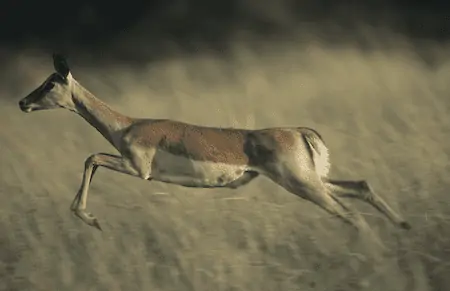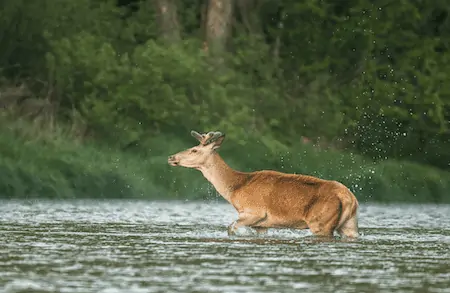Deer, as we all know, are highly agile creatures. Their running speed allows them to disappear into the distance in a matter of seconds.
But what about deer in water? Do they do as well as they do on land? Can deer swim? In short, yes, deer can swim.
Yet, it’s easy to guess deer aren’t made for swimming from their looks. Lean and light, they have legs designed for running. But those two things should also prove helpful to a certain extent when swimming, shouldn’t they?
That’s right! As a matter of fact, deer are skilled swimmers capable of traveling in groups across ‘any’ moving water body.
Sounds interesting? Read ahead to find more astounding facts about deer swimming.
Table of Contents
Deer Survive On Speed
One thing becomes instantly evident when looking at a deer: it’s built for speed. They have lean and elegant figures, featuring thin legs and compact bodies. Their sole purpose of living is to feed on shrubs and run away from predation.
Deer generally follow the best bits of foliage wherever they find them, migrating from place to place. So maybe it should not surprise us that deer have mastered the art of crossing water bodies.
But do swimming deer have a chance of escaping a predator?
Millions of years of evolution have endowed deer with the ability to know precisely what to do to survive, which usually means running away from something pretty fast and dangerous.
Running alone is not always enough to escape safely. It sometimes becomes a calling to take other steps to ensure that the deer herd and its members are safe. When times like this arise, deer know to swim across the water to stay safe.
What Makes Deer Such Good Swimmers?
Deer are excellent swimmers for several reasons.
Among them are:
#1. Body Structure
Swimming is a perfect fit for a deer’s body shape. Deers have incredibly strong hooves and leg muscles. Besides, they have excellent stamina because of their lower body fat and thus can swim without fatigue for extended periods.
#2. Coat
Water is safe for deer because of its coat, consisting of an undercoat and a topcoat. The undercoats are woolly and dense.
This extra insulation prevents excessive heat loss when the animal swims in water for prolonged periods.
Unlike the undercoat, the topcoat has long, hollow hairs. Because of the buoyancy it provides, the animal can maintain enough of its body (more than one-third) above the water’s surface.
The deer needs less energy to propel itself against the water’s resistance when enough of its body remains above the water.
#3. Powerful Legs
The powerful legs of deer enable them not only to run faster but also to swim faster. Particularly impressive are the hind legs, which are exceptionally strong and full of stamina.
Besides, their leg movements are just as spontaneous in water as on land.
Why Do Deer Swim?
If it needs to cross a body of water in search of food or to make its way away from danger, a deer will swim.
They boast extraordinary hearing, partly due to how they move their ears independently, thanks to some unique muscles. Also, deer have a sharp sense of smell, which alerts them of nearby predators.
When a deer goes into the water, it usually does so because it is frightened and wishes to escape danger. If you spot a pregnant deer swimming, chances are it’s heading to an island where she can safely give birth to her fawns.
Deer tend to like swampy areas, which is one reason they might end up swimming. There are many hiding places for deer in swampy areas with dense foliage, while such regions also provide plenty of food.
How Fast Can Deer Swim?
On average, Deer can swim up to 10 miles without fatigue, proving how strong and hardy they are. This mechanism relies on their highly developed leg muscles and hooves, allowing them to traverse waterbeds for prolonged periods.
You may not correctly presume how powerful they could be in the water, but watching those deer videos on YouTube or the Discovery Channel might give you some idea.
You haven’t seen anything like this, here’s a video for you.
When a predator attacks, you’ve likely noticed how quickly the group runs away. Some deer have even been seen moving through hungry crocodiles resting in the water.
It has been documented that some deer can travel at 15mph on water. The air-filled hollow hair-made topcoat is the driving force behind such speed, making it easy to float.
How Many Species of Deer Can Swim?
In general, all deer species are capable of swimming.
You can verify this hypothesis by setting up a pond for your adult pet deer. If you search on YouTube, you’ll come across videos of different deer species swimming for hours, like athletes.
But what deer species does the best swimming? Water Deer, of course.
Water Deer
This unique deer species lives in shallow watery areas near river bottoms. Its two known subspecies are Korean water deer (Hydropotes inermis argyropus) and Chinese water deer (Hydropotes inermis inermis).
Essentially identical to musk deer, both subspecies have prominent tusks, earning the nickname- ‘Vampire deer.’
Water deer have a narrow pectoral and pelvic girdle, a long neck, and correspondingly long legs for optimum swimming efficiency.
Besides, their haunches are higher than the shoulders because their hind legs are longer and more powerful than the front ones.
How About Whitetail Deer?
White-tailed deer are common to find in North and Central America. Whitetail deer’s swimming ability is undeniable, despite popular belief that they cannot swim because of their wide hoof clefts.
Their swimming speeds have been recorded as high as 13-15 mph.
What About Mule Deer?
Mule deer got its name from its ears, which resemble those of mules. Due to its bulky antlers and stocky body frame, many believe they have little chance of swimming.
But that’s far from the truth; the Mule Deer can swim well when needed. It’s not uncommon to come across Mule Deer in the middle of the Columbia River (which is 1243 miles long), showing how strong and resilient swimmers they are.
Are Moose, Elk, Sambar, or Reindeer Swimmers Too?
Yes, they are, despite not being as fast as their smaller-sized counterparts!
Although they’re often seen slowly walking through narrow creeks with bulky weight, they’re pretty comfortable swimming to reach islands for food or safety when the time comes.
The Reindeer can even swim past a cold pond in sub-zero temperatures without much trouble.
Can Deer Swim Underwater?
Underwater swimming is on an entirely different level. Astoundingly, however, some deer are adept at it. Among the species exhibiting this remarkable trait, the Mouse-deer stands out.
Such deer live in the Indonesian countryside. Indigenous tribes claim that these deer can submerge themselves underwater when threatened by predators.
In addition, there’s the water chevrotain (Hyemoschus aquaticus) living in the swampy African habitats.
When frightened, the animal dives into a nearby water body, then stays submerged until it is safe to come out of the water again.
Can Deer Swim In The Ocean?
It might be surprising to know that deer can even swim in oceans and other deep bodies of water without drowning.
It’s primarily due to their powerful legs, as they can jump over fences as high as nine feet.
Can Baby Deer Swim?
We’ve already learned that adult deer are excellent swimmers; some even swim underwater. However, a baby deer may find swimming in the water pretty challenging.
Compared to an adult, deer baby legs aren’t fully developed, and their hollow hair isn’t as dense as that of an adult. Besides, due to their immaturity, baby deer tend to tire quickly.
There have been many reports of trapped baby deers in local pools. Animal control or some experienced individual will need to help them in such cases to ensure their safe recovery.
However, they may not always have such luck and drown after hours of paddling.
In answer to the question, Can deer babies swim?
Yes.
Are they as good as adults in the water?
No.
Do Deer Like Swimming?
When you know how good swimmers deer are, it’s easy to assume they enjoy the water. The truth, however, is quite different.
Deer don’t swim for pleasure, nor do they spend time splashing around in the water. When running away from predators, looking for food or shelter, only then they’ll swim.
When there is no danger nearby, they will only go near water when thirsty. Even then, they’ll remain watchful for predators lurking in the water.
They don’t even like water when it’s raining. Drizzling rainfall hinders deers’ hearing, leaving them unaware of nearby dangers.
Because of this, they fall victim to their predators easily during windy rains.
What To Do If You See A Deer Swimming?
Imagine spotting a deer swimming in a creek, lake, or pond. What should you do? Should you try to rescue it?
No, you shouldn’t. For the most part, you shouldn’t take any action whatsoever.
It’s a good idea to contact local wildlife authorities if you believe the animal might be in distress. But try not to handle the situation yourself. Not only could this cause injury to yourself, but also the deer.
There are two reasons for this: You may use inappropriate equipment or inflict stress on the animal to the point where it’s no more able to stay afloat.
Rescue teams and wildlife authorities will have specialized equipment to protect themselves and deer. If you are worried about the deer, you can monitor it while keeping a safe distance so that it doesn’t feel in danger until help arrives.
Must Read: Why Do Deer Freeze in Headlights
Conclusion
By now, you must be shocked to learn how capable deer are if you don’t live in a deer-populated area. Can deer swim? Indeed, if they must.
Much like other wild animals, deer live to survive. It uses swimming skills whenever it’s a calling rather than a choice, like escaping predators or finding food. A few may also take a dip to drown stinging ticks, mosquitoes, or other bugs.
So, remember to watch for a deer swimming in the wild if you’re out early in the morning someday.


